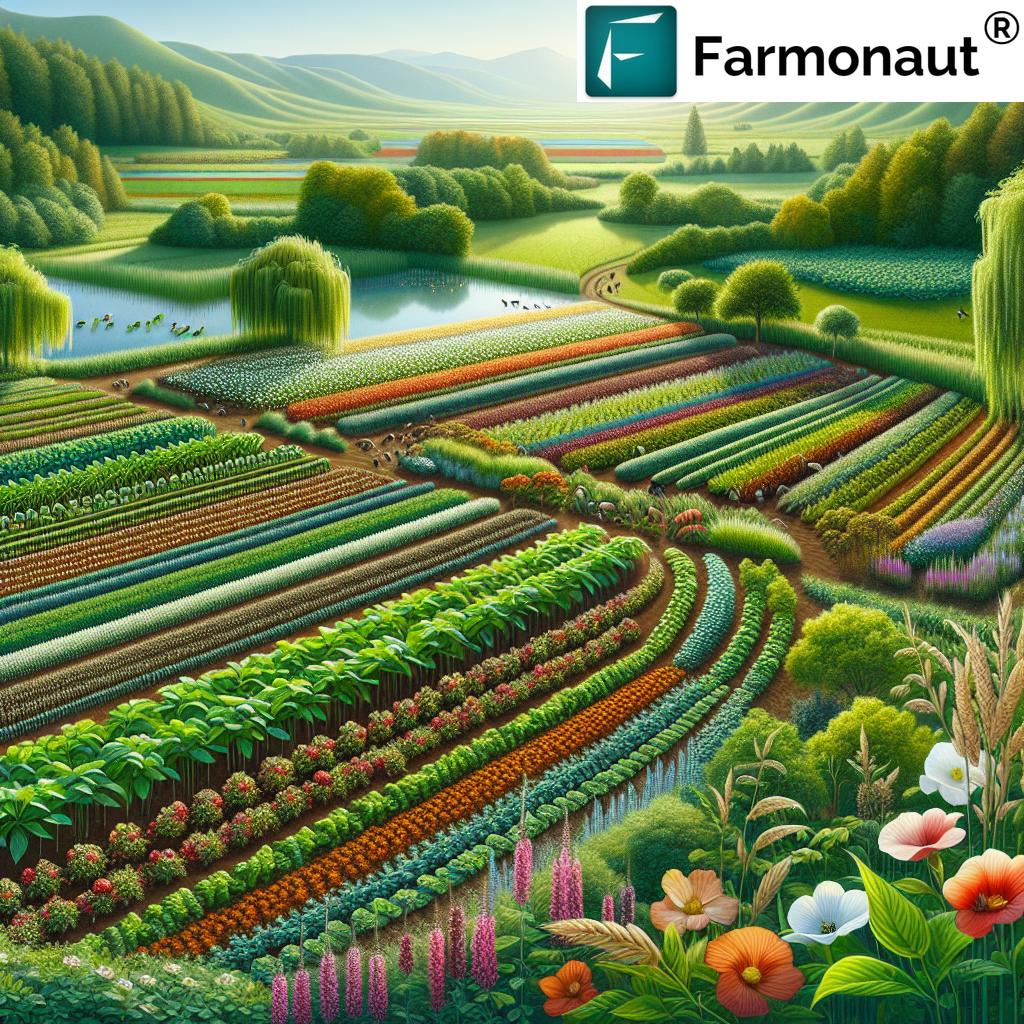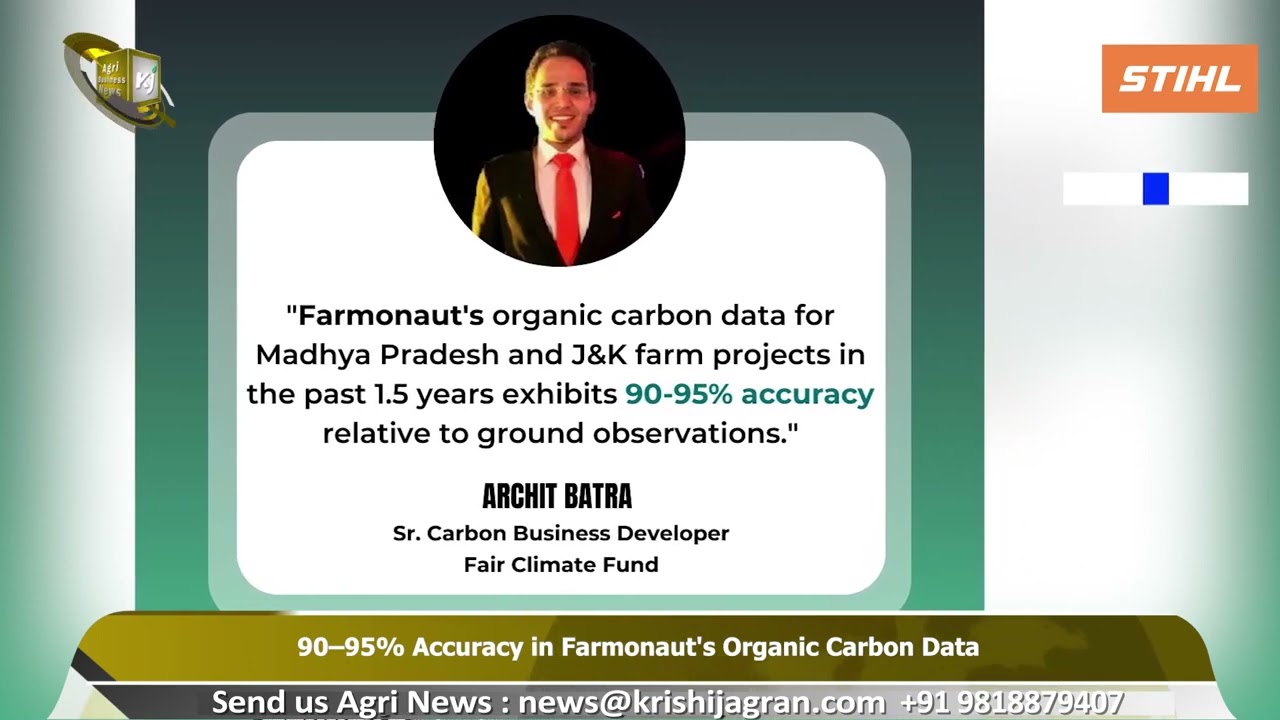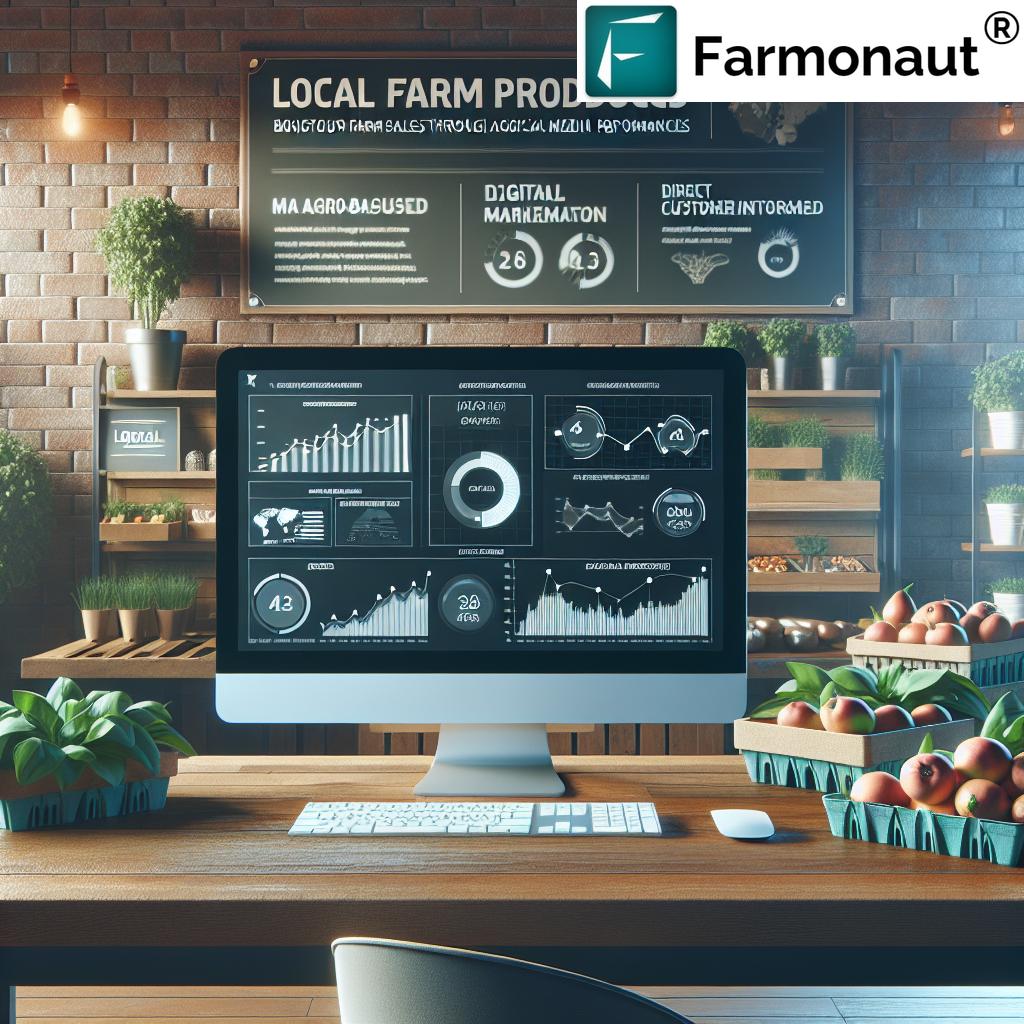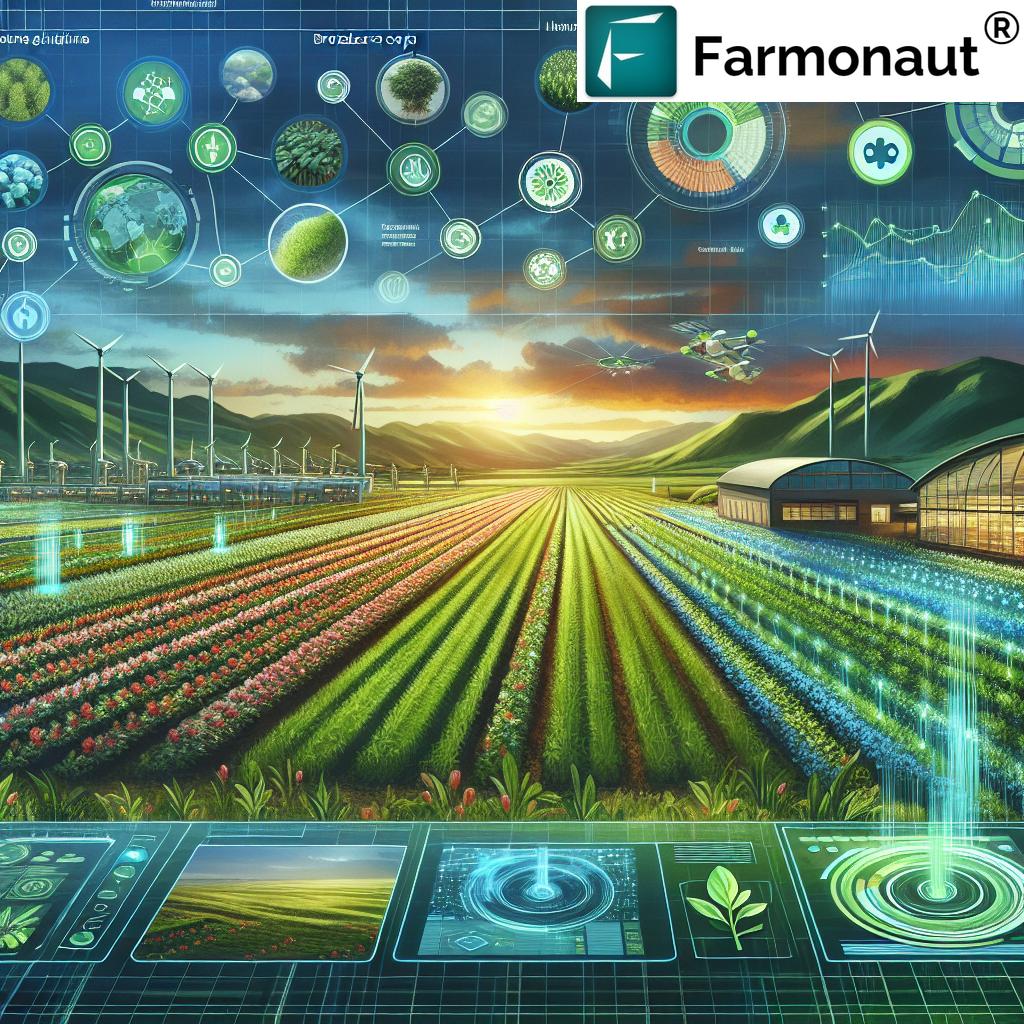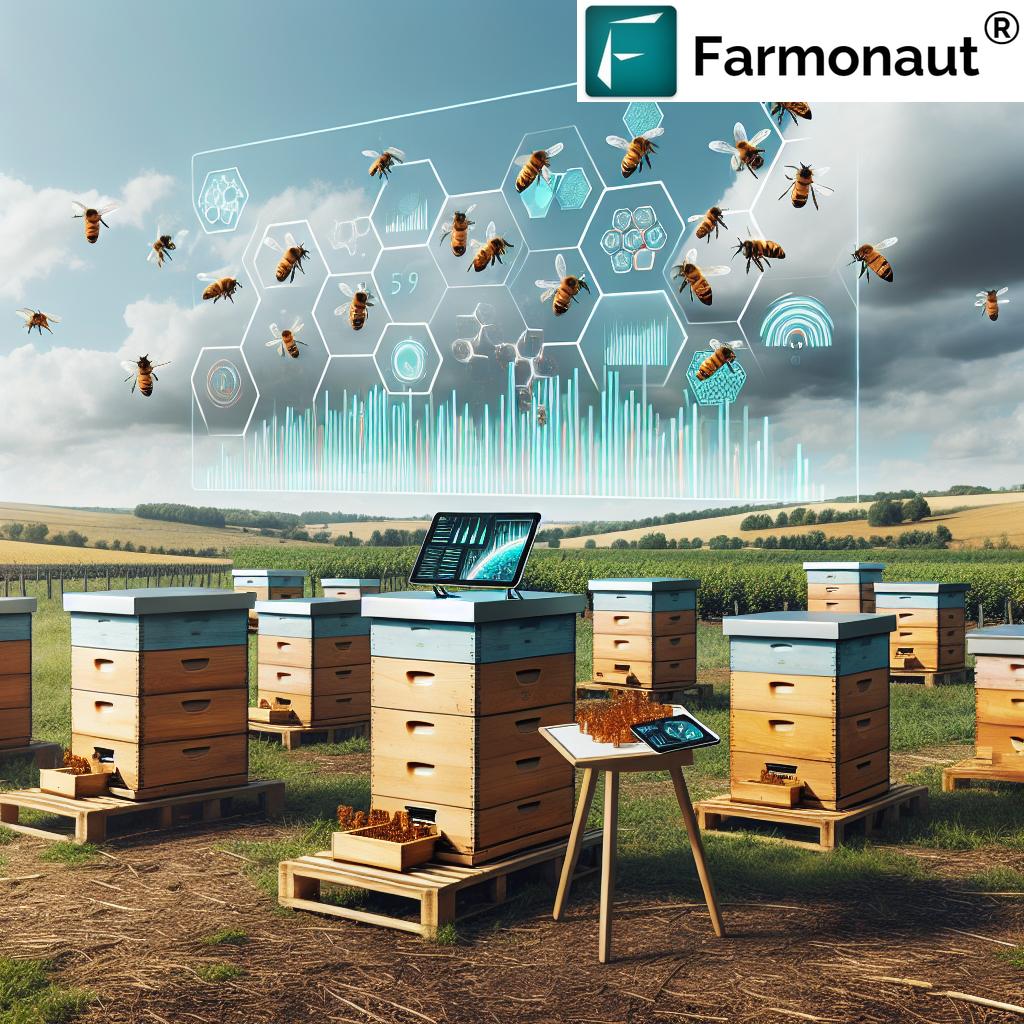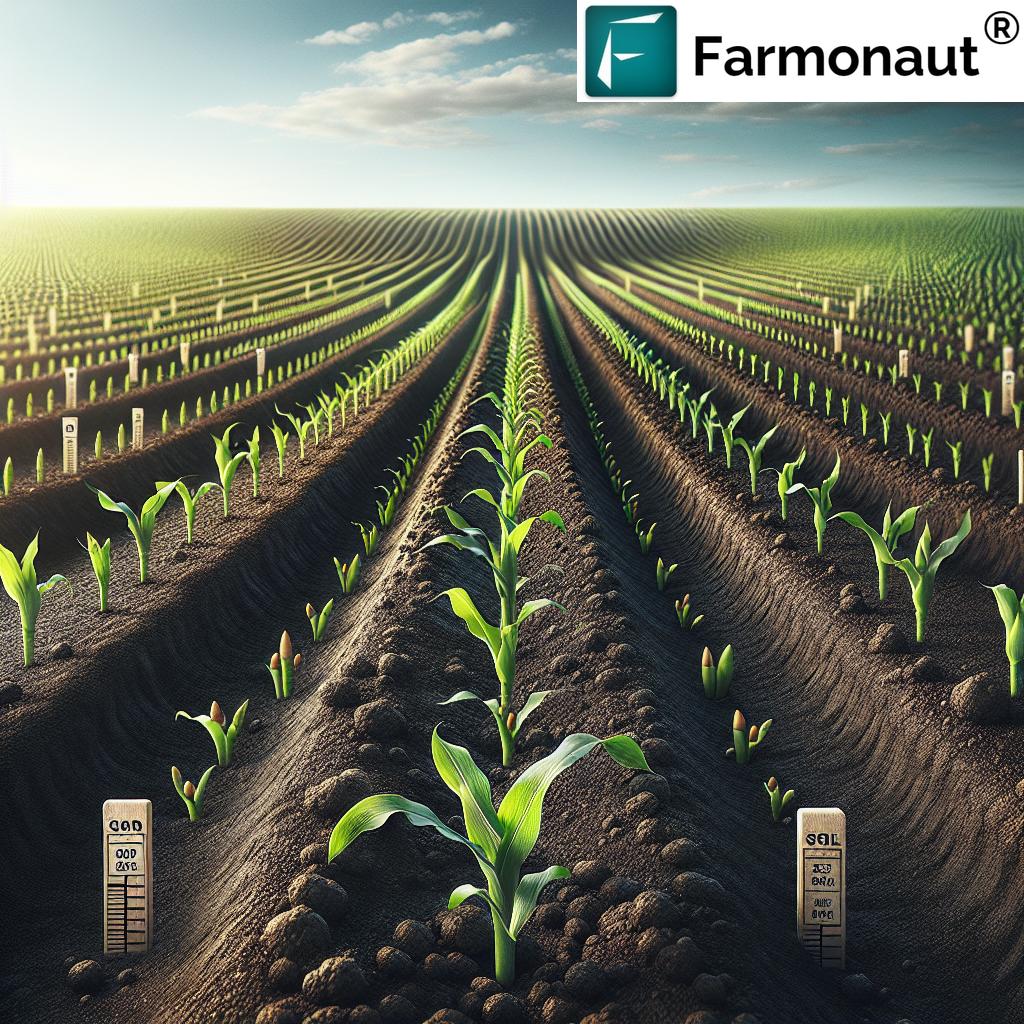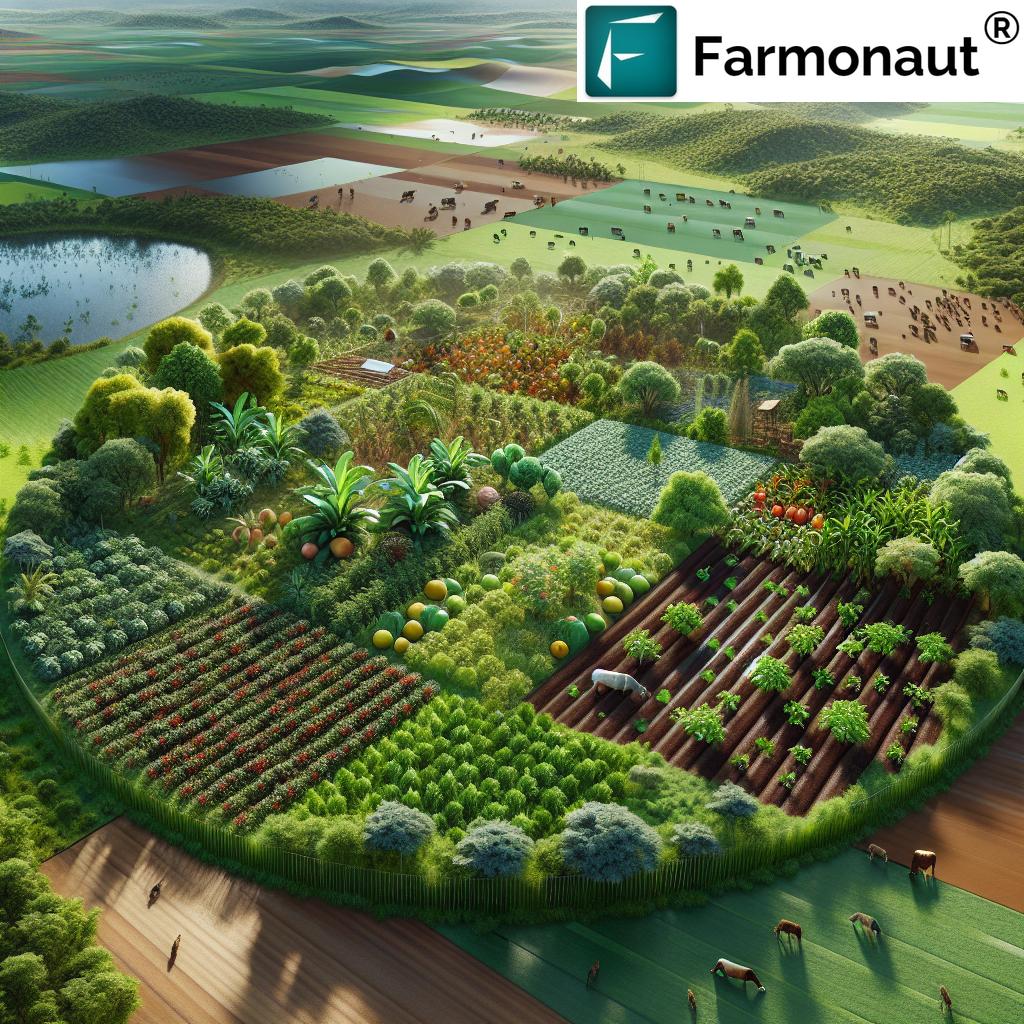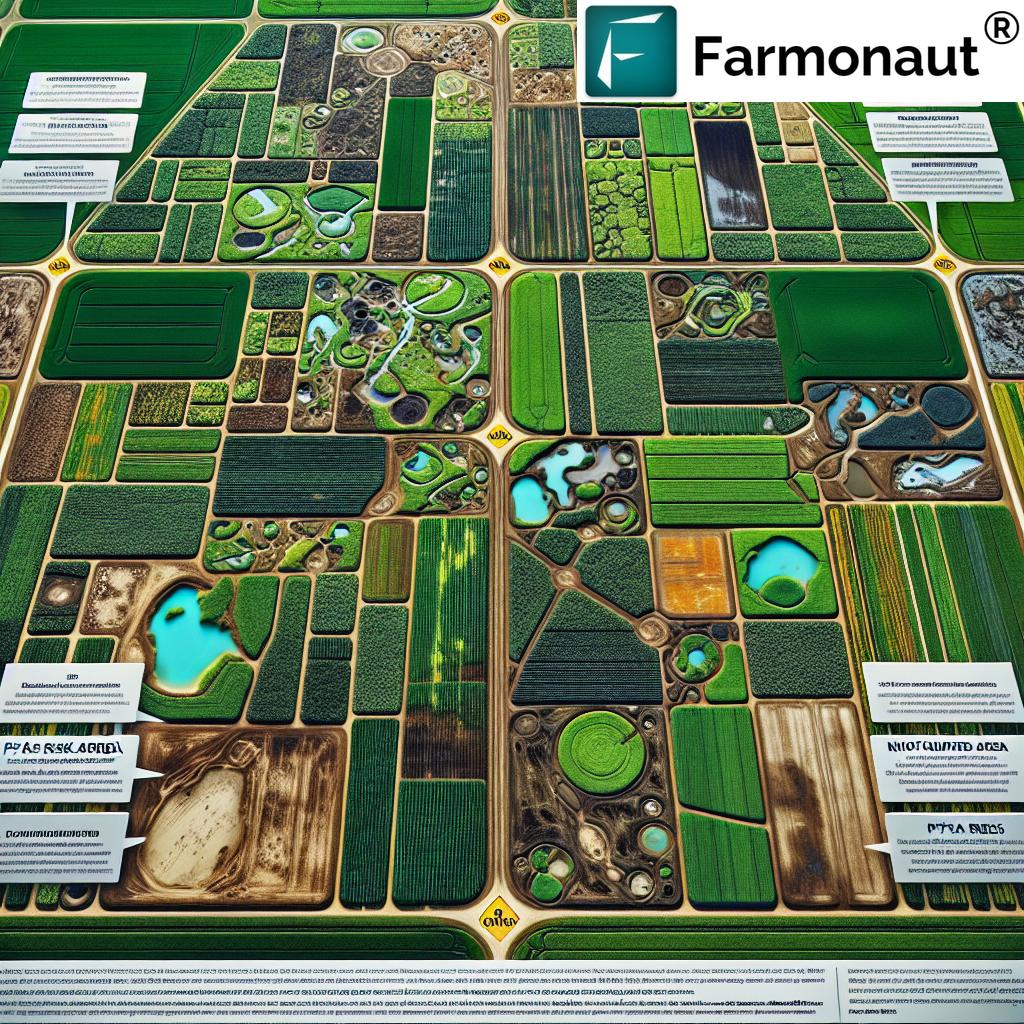Organic and Sustainable Agriculture: 7 Biodiversity Tips
A Comprehensive Overview of Organic and Sustainable Farming for Soil Health, Biodiversity Conservation, and Food Security
Table of Contents
- Summary: Organic and Sustainable Agriculture
- Introduction to Organic and Sustainable Agriculture
- Principles and Key Practices
- 7 Biodiversity Tips for Organic & Sustainable Farming
- Comparative Benefits: Biodiversity Tips Table
- Biodiversity Conservation in Agriculture: Ecosystem Services
- Soil Fertility Management & Health
- Eco-Friendly Crop Rotation Methods
- Biological Pest Control in Organic Agriculture
- Water Management in Farming
- Reducing Energy Use and Environmental Impact
- How Farmonaut Advances Sustainable Agriculture
- Economic and Social Aspects of Organic Farming
- Organic Farming Challenges: Overcoming Barriers
- Understanding the Organic Certification Process
- Global Perspectives: France, Africa & Worldwide Trends
- FAQ: Organic & Sustainable Agriculture
- Conclusion: Shaping the Future of Sustainable Food Systems
Summary: Organic and Sustainable Agriculture
Organic and sustainable agriculture stand at the forefront of modern farming approaches that embrace environmental balance, social well-being, and long-term productivity. Unlike conventional farming, these systems emphasize natural processes, soil fertility management, biodiversity conservation, and the avoidance of synthetic pesticides, fertilizers, or genetically modified organisms (GMOs). While organic farming has become synonymous with eco-friendly food production, sustainable agriculture encompasses a broader range of strategies designed to preserve resources for future generations.
Together, these approaches aim to produce nutritious food by enhancing soil health, optimizing crop rotation methods, practicing biological pest control, and building resilient communities—all in harmony with nature.
Introduction to Organic and Sustainable Agriculture
As concerns about environmental degradation, soil fertility, climate change, and loss of species diversity grow, organic agriculture and sustainable farming practices have emerged as essential solutions. These systems promote the health and well-being of people, animals, and ecosystems alike.
The International Federation of Organic Agriculture Movements (IFOAM) defines organic agriculture as an integrated system that strives for sustainability, the enhancement of soil fertility and biological diversity while, with rare exceptions, prohibiting synthetic pesticides, antibiotics, fertilizers, GMOs, and growth hormones.
The principles of sustainable agriculture include environmental health, economic profitability, and social equity. Both systems recognize that managing agricultural land in a way that works with nature—rather than against it—is critical for the future of food and farming.
Principles and Key Practices in Organic and Sustainable Agriculture
- Ecological Balance: Emphasizing natural nutrient cycling, conserving biodiversity, and maintaining soil and water resources.
- Resource Efficiency: Reducing dependency on non-renewable inputs and external resources, especially synthetic fertilizers and pesticides.
- Support for Local Communities: Building rural economies and fostering knowledge-sharing.
- Soil Fertility Management: Sustaining soil health through composting, rotation, green manuring, and minimal tillage.
- Biodiversity Conservation in Agriculture: Creating resilient farming systems that protect and enhance ecosystem services.
- Biological Pest Control: Harnessing natural predators, crop rotation, and resilient cultivars to reduce disease and pest outbreaks.
- Conservation of Water & Energy: Preserving water resources and minimizing energy consumption.
7 Biodiversity Tips for Organic & Sustainable Agriculture
Enhancing biodiversity is central to both organic and sustainable agriculture. Diverse landscapes are more resilient to pests, weather extremes, and disease outbreaks, support more pollinators, and maintain ecological balance.
Below are 7 evidence-based tips to promote biodiversity on your farm, improve soil structure, and ensure long-term productivity.
1. Practice Diverse Crop Rotations
One of the most effective crop rotation methods involves alternating different crops—like cereals, legumes, and root crops—in planned sequences. This disrupts pest cycles, improves soil fertility, and supports various soil microorganisms.
Did you know? Crop rotation in sustainable agriculture can reduce soil erosion by up to 50%, preserving long-term soil health.
2. Implement Agroforestry and Hedgerow Planting
Integrating trees, shrubs, and perennial plants (agroforestry) with crops can boost biodiversity—providing habitat and food sources for birds, pollinators, and beneficial insects. Hedgerows—dense rows of shrubs or trees at field edges—also serve as windbreaks, reduce soil erosion, and buffer against nearby pesticide drift.
3. Maintain Permanent Cover Crops and Green Manures
Growing cover crops (like clover, vetch, or rye grasses) in between main crops increases organic matter, suppresses weeds, and enhances soil structure. Green manures—crops grown specifically to be incorporated into the soil—add nutrients and stimulate soil microbial communities.
4. Enhance Field Margins and Protect Natural Habitats
Leaving uncultivated strips (field margins) around farmed land supports wildflowers, insects, and small mammals. Protecting natural habitats—ditches, ponds, woodlots—within your land enhances on-farm biodiversity and ecosystem resilience.
5. Use Biological Pest Control & Reduce Synthetic Inputs
Organic and sustainable farms avoid synthetic pesticides by encouraging natural enemies (ladybeetles, birds, parasitoid wasps) of crop pests. Rotating crops, mixed planting, and releasing beneficial insects (biocontrol agents) are proven strategies to reduce synthetic inputs and maintain ecological balance.
6. Support Soil Health through Organic Amendments and Composting
Adding compost, farmyard manure, and organic amendments nourishes the soil food web and supports a wide variety of organisms, from earthworms to fungi. Healthy, living soils increase crop resilience, support biodiversity, and enhance nutrient cycling.
7. Integrate Livestock & Mixed Farming Systems
Integrating animals, when managed carefully, can stimulate plant growth, cycle nutrients, and reduce external input needs. Mixed systems—where crops and livestock interact—help distribute manure, control pests (e.g., ducks in rice paddies), and diversify farm income streams, while supporting a complex web of farm biodiversity.
Comparative Benefits: Biodiversity Tips Table
| Tip Number | Biodiversity Tip | Estimated Improvement in Soil Fertility (%) | Potential Increase in Local Biodiversity (species supported) |
Impact on Crop Yield Stability (%) |
|---|---|---|---|---|
| 1 | Diverse Crop Rotations | +20% | +20 species | +18% |
| 2 | Agroforestry & Hedgerows | +10% | +25 species | +12% |
| 3 | Permanent Cover Crops | +24% | +10 species | +15% |
| 4 | Field Margins & Habitat Protection | +7% | +30 species | +10% |
| 5 | Biological Pest Control | +8% | +12 species | +11% |
| 6 | Organic Amendments & Composting | +27% | +9 species | +17% |
| 7 | Livestock Integration & Mixed Farming | +15% | +18 species | +13% |
Together, these seven biodiversity tips form the backbone of environmentally sustainable and organic agriculture, combining ecological principles with practical management to boost both yields and the living landscape.
Biodiversity Conservation in Agriculture: Ecosystem Services
Biodiversity conservation in agriculture not only supports increased species richness but also underpins critical ecosystem services, such as:
- Pollination: Wild pollinators, such as bees and butterflies, are more abundant in organic farms with floral field margins and lower pesticide use.
- Pest Control: Diverse habitats support beneficial predatory insects and birds that regulate pest populations—reducing reliance on synthetic pesticides.
- Soil Formation and Nutrient Cycling: Earthworms, mycorrhizal fungi, and bacteria aerate soil, increase nutrient availability, and break down organic matter.
- Water Regulation: Organic matter increases water-holding capacity, buffers floods or droughts, and filters water, improving landscape resilience.
- Carbon Sequestration: Diverse plantings, cover crops, and reduced tillage lock carbon in both soil and plant biomass.
Preserving on-farm biodiversity means healthier crops, more resilient systems, and enhanced sustainability for future generations.
Soil Fertility Management & Health
Soil is the living foundation of sustainable and organic agriculture. Maintaining its structure, organic matter content, and biological activity is vital for long-term productivity, ecological balance, and food security.
- Composting: Decomposed organic matter (compost) improves soil texture, supplies nutrients, and boosts microbial activity.
- Green Manuring: Incorporating leguminous cover crops adds nitrogen and organic material, decreasing the need for synthetic fertilizers.
- Reduced Tillage: Limits soil disturbance, decreases erosion, and preserves mycorrhizal networks.
- Soil Testing: Routine analysis enables targeted application of organic amendments, preventing overuse and nutrient runoff.
For real-time soil health monitoring and data-driven decisions, Farmonaut offers satellite-based, app-accessible solutions to help optimize on-farm soil fertility management and increase profitability.
Unlock soil carbon, track nutrients, and optimize crop inputs using Farmonaut’s advanced platform—learn more and start here.
Eco-Friendly Crop Rotation Methods
A key component of organic and sustainable agriculture, crop rotation methods involve growing different types of crops in sequential seasons on the same land. Advantages include:
- Disrupting Pest and Disease Cycles: Alternating host crops interrupts pest lifecycles naturally.
- Maintaining Soil Fertility: Rotating legumes after cereals restores nutrients and reduces nitrogen depletion.
- Enhancing Biodiversity: Diverse rotations attract beneficial insects and maintain a varied soil microbiome.
- Reducing Weeds: Changing crop height and root structure suppresses problematic weeds without herbicides.
- Improved Yield Stability: Healthy rotations buffer yield losses during extreme weather or pest outbreaks.
For large-scale, complex rotation planning and tracking, Farmonaut provides remote monitoring tools and insights through its satellite-enabled dashboard—boosting decision-making for farms in France, Africa, and worldwide.
Biological Pest Control in Organic Agriculture
Chemically-intensive pest management routinely disrupts natural balances and harms beneficial organisms. Biological pest control emphasizes:
- Encouraging Natural Predators: Creating habitats for ladybugs, lacewings, birds, and bats.
- Introducing Biocontrol Agents: Using parasitoids, nematodes, and fungi that target specific pests.
- Resilient Varieties: Planting disease-resistant and locally-adapted crop varieties.
- Intercropping and Trap Cropping: Planting species mixes that confuse pests or draw them away from main crops.
Organically managing pests preserves ecosystem balance, limits resistance development, and protects pollinators and human health.
Farmonaut’s platform helps identify early signs of pest outbreaks via AI-based data analysis, supporting effective and sustainable intervention across all types of farming systems.
Water Management in Farming
Organic and sustainable practitioners prioritize water conservation and management because healthy soil retains more water and reduces the need for irrigation. Top strategies include:
- Mulching: Applying organic cover to insulate soil and minimize evaporation.
- Contour Farming and Terracing: Mitigating runoff and enhancing water infiltration.
- Reduced Tillage: Preventing crust formation and increasing water absorption.
- Cover Crops: Their roots help maintain moisture and prevent soil erosion.
Research shows that organic farms use water more efficiently, helping future generations adapt to climate variability and drought events.
Monitor irrigation needs, track rainfall, and plan water-efficient strategies with Farmonaut’s farm management application—ideal for both individual farmers and large agribusinesses.
Reducing Energy Use and Environmental Impact
One of the central environmental benefits of organic farming is energy efficiency. With reduced dependence on synthetic fertilizers and pesticides, energy use (especially fossil fuels) often drops. Other methods for reducing the farm’s carbon footprint include:
- Adopting local, renewable resources over imported synthetic inputs
- Practicing minimum or no-till farming to lower emissions
- Utilizing crop residues and farm wastes as organic amendments
Farmonaut’s Carbon Footprinting platform empowers farmers and businesses to calculate, track, and minimize their greenhouse gas emissions using real-time, satellite-derived farm data—contributing to farm profitability and compliance with environmental regulations.
How Farmonaut Advances Sustainable Agriculture
At Farmonaut, we place innovation and data-driven sustainable farming practices at the core of our mission. Our platform empowers farmers and agribusinesses to leverage:
- Satellite-Based Crop Health Monitoring: Get actionable insights into crop vigour, soil moisture, and vegetation health using NDVI and multispectral imaging.
- Jeevn AI-Based Advisory: Receive AI-driven, personalized tips on best soil fertility management, pest and disease identification, and weather forecasts for timely interventions.
- Blockchain-Based Traceability: Maintain transparent product traceability from farm to fork, bolstering consumer trust and supporting sustainable supply chain claims.
- Fleet and Resource Management: Improve logistics, scheduling, and resource use with the Fleet Management system, reducing operational costs and maximizing efficiency.
- Carbon Footprint Tracking: Measure and reduce your farm’s carbon emissions while supporting sustainability certifications and insurance eligibility.
- API Integration: Plug into Farmonaut’s ecosystem for automated data pipelines—developers can access our API here and find documentation here.
We support growers of every scale—from smallholders to large corporate operations—in France, Africa, India, and globally, with affordable, scalable, and sustainable farm management technology.
Ready to empower your farming community or agribusiness?
Economic and Social Aspects of Organic Farming
Sustainable and organic agriculture delivers multiple benefits to rural communities and the broader food system:
- Market Potential & Profitability: Premium pricing for organic products can offset slightly lower yields and higher labor needs, especially when direct access to local markets is established.
- Cost Reductions: Over time, farmers can see reduced input costs by eliminating external synthetic inputs in favor of farm-produced fertility and pest control resources.
- Local and Traditional Support: These approaches support traditional farming knowledge, rural jobs, and a sense of community ownership.
- Social Sustainability: Emphasis on fair wages, participatory decision-making, and safe working conditions is integral to certification standards.
With Farmonaut’s blockchain traceability, transparent product journey, and carbon tracking, farmers improve market access and eligibility for sustainable supply chains.
Organic Farming Challenges: Overcoming Barriers
No approach is without challenges. Some key organic farming challenges include:
- Transition Period: Conversion from conventional to organic management can lead to temporary yield drops.
- Knowledge Demands: Higher need for technical know-how and ongoing education in pest, fertility, and rotation management.
- Certification Costs: The organic certification process (compliance, monitoring, and paperwork) adds financial and administrative pressures, especially for smallholders.
- Market Fluctuations: Prices for organic products in global markets can be volatile, as seen in France’s shrinking organic land in 2023.
- Yield Comparisons: Studies show organic yields can be 10–20% lower than conventional, though sometimes higher in drought conditions.
However, access to tools, technology, and transparent information—like Farmonaut’s digital platform—reduces many of these challenges in both developed and resource-limited regions.
Understanding the Organic Certification Process
Certification assures consumers that products meet defined organic standards:
- Prohibits most synthetic fertilizers, pesticides, antibiotics, and GMOs
- Requires record-keeping of all inputs, processes, and financial transactions
- Mandates buffer zones between organic and conventional fields
- Demands regular soil and water testing
- Ensures compliance through annual audits by national or international bodies (such as IFOAM)
Despite upfront costs, certification helps secure price premiums, improve market access, and build trust.
Global Perspectives: France, Africa & Worldwide Trends
Organic agriculture is practiced in over 187 countries, with most organic land in Oceania, Europe, and Latin America. France—once a European leader—saw its organic area shrink for the first time in 2023, reflecting broader debates over food affordability and market saturation.
In Africa, some governments prioritize increasing fertilizer use (as in the Nairobi Declaration), while many local communities and NGOs support agroecological, low-input paths to sustainable yield growth. The tension between modern “green revolution” technologies and traditional knowledge persists, highlighting the need for scalable, context-sensitive solutions.
Globally, demand for organic products continues to rise, with over 3 million certified organic farmers worldwide. The environmental benefits of organic farming and sustainable food systems are increasingly recognized as essential for a resilient future.
- Debate rages over push for new green revolution in Africa’s agriculture
- Why Organic Food Might Be Worth the High Price
- France’s organic farmed land shrunk for the first time in 2023
FAQ: Organic & Sustainable Agriculture
- 1. What is the difference between organic and sustainable agriculture?
- Organic agriculture follows strict rules regarding the prohibition of synthetic pesticides, fertilizers, antibiotics, GMOs, and growth hormones, while sustainable agriculture is a broader concept focused on long-term environmental health, economic viability, and social equity. Not all sustainable farms are certified organic, but all organic farms aim for sustainability.
- 2. How does crop rotation support soil health?
- Crop rotation methods disrupt pest and disease cycles, replenish soil nutrients, reduce erosion, and support a diverse community of soil organisms, resulting in improved soil fertility and yield stability.
- 3. Why does organic certification cost more?
- The organic certification process includes fees for registration, annual audits, and documentation. These costs ensure rigorous compliance but may be challenging for small-scale farmers without external support or group certification programs.
- 4. Are organic yields always lower than conventional?
- On average, organic yields are 10–20% lower, but they can outperform conventional during droughts or when soils are highly degraded. With soil health restoration and efficient management, yield gaps may decrease over time.
- 5. How can technology support sustainable agriculture?
- Technologies like satellite-based crop monitoring, AI-powered advisory, resource tracking, and blockchain product traceability (as provided by Farmonaut) make sustainable decision-making, data management, and market access more affordable and scalable for all.
- 6. Does organic farming benefit pollinators and wildlife?
- Absolutely. Organic systems restrict harmful chemicals, increase flowering habitats, and leave wild areas for birds, mammals, and beneficial insects—contributing to a 30% or greater rise in on-farm biodiversity.
- 7. Is sustainable agriculture possible in regions with poor soils or water scarcity?
- Yes. With soil-building techniques, efficient water management, drought-tolerant crop varieties, and precise monitoring provided by digital tools, even challenging environments—such as parts of Africa—can transition to more resilient, sustainable systems.
Conclusion: Shaping the Future of Sustainable Food Systems
Organic and sustainable agriculture offer proven pathways to restore soil fertility, enhance biodiversity, and secure resilient food production for both present and future generations. While challenges remain, integrating science-based practices—such as diverse crop rotation methods, biological pest control, and biodiversity conservation in agriculture—can dramatically improve outcomes for farms, communities, and our planet.
With the support of advanced technologies like Farmonaut’s satellite monitoring, blockchain, and AI-driven insights, it is easier than ever to implement these approaches and keep farms productive, profitable, and environmentally responsible.
To get started—or to supercharge your organic and sustainable farming practices—try Farmonaut’s web or mobile app, or integrate our API into your digital tools. Empower your decisions, enhance productivity, and steward the land for a brighter farming future!


